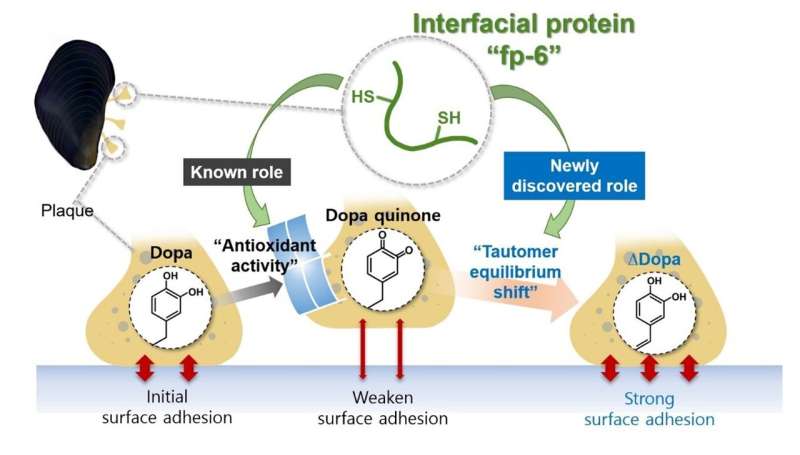How mussels maintain adhesion underwater

Bathroom accessories mounted on tile walls often fall off if not mounted correctly. This is because the moisture in the bathroom weakens the surface adhesion. Conversely, mussels boast amazing adhesion as they stick firmly to rocks even underwater. Although studies are being conducted to utilize these mussel adhesive proteins (MAPs) as an adhesive, its vulnerability to oxidation has made it difficult to fully recreate their underwater strength.
Recently, a POSTECH research team led by Professor Hyung Joon Cha, Dr. Mincheol Shin, and Ph.D. candidate Taehee Yoon (Department of Chemical Engineering) has verified the secret to the strong surface adhesion of mussel adhesive proteins (MAPs) even in an environment that causes oxidation. These findings were recently published in the journal Langmuir.
MAP is gaining attention as a biomedical material used as a bioadhesive or a drug delivery system as it is nature-derived and harmless to the body. However, there was a limitation in that Dopa, a major component of the mussel adhesive protein, is easily oxidized which leads to weakening of the surface adhesion.
The research team focused on the fact that among the surface proteins of mussels, cysteine-rich proteins are involved in oxidation and reduction. When Dopa was oxidized to Dopa quinone with weakened adhesion, the research team added protein type 6 (fp-6) that contains cysteine, which changes the Dopa quinone into △Dopa. △Dopa is a tautomer of Dopa quinone and has a very strong surface adhesion like Dopa.
The research team also verified that when △Dopa is formed in the protein, it can have a stronger surface adhesion than Dopa.
This study is the first study to verify that the fp-6 shifts the tautomer equilibrium of oxidized Dopa to make mussels stick strongly to surfaces even in the oxidative underwater conditions. Applying these findings to the Dopa-based underwater adhesive can increase its surface adhesion.
Professor Hyung Joon Cha explained, "We have verified for the first time that the cysteine-rich surface protein, conventionally known to block oxidation of Dopa, also promotes the change into △Dopa, which helps to maintain the adhesion in mussels even in oxidative underwater environments."
More information: Mincheol Shin et al, Thiol-Rich fp-6 Controls the Tautomer Equilibrium of Oxidized Dopa in Interfacial Mussel Foot Proteins, Langmuir (2022). DOI: 10.1021/acs.langmuir.1c03239
Journal information: Langmuir
Provided by Pohang University of Science & Technology (POSTECH)



















